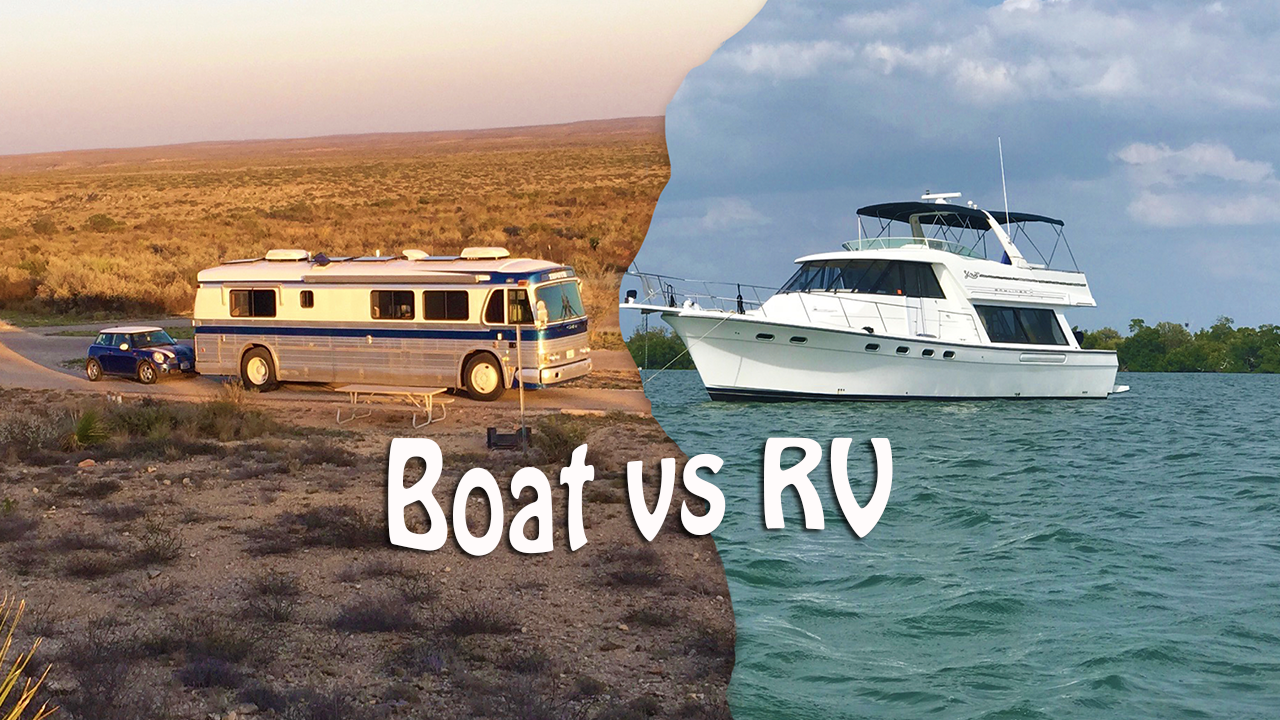
We’ve now been living aboard our boat Y-Not for 2 months, and it seems like a good time to share some of our initial thoughts on the lifestyle differences from our RV-life.
This is by no means a competition between RV and boat life – we absolutely love RVing, and look forward to moving back aboard Zephyr seasonally. And these are just initial impressions, two months does not make us experts on the subject.
But we did want to capture our thoughts while they were fresh in our mind.
If you’re video inclined, we hosted a live video session on this topic a couple weeks ago, and you can view the archive instead (it is nearly an hour long). Or if you prefer, we’ve written about the highlights below.
Living Space
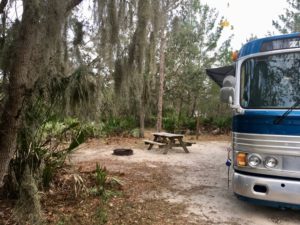
When you travel in an RV, usually the space around your parking spot becomes part of your living space. It’s like pulling into a new yard every stop.
You can walk around that space, set-up outdoor furniture, utilize it for a picnic, have a nap in the hammock, make S’mores over the campfire or just enjoy watching squirrels jump between trees.
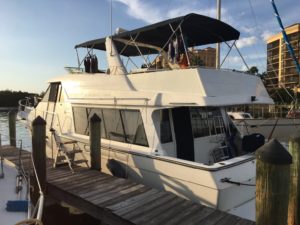
That’s not so much the case with a boat. In a marina, you have just a little dock space outside your door that’s not functional as a yard.
And when anchored you’re surrounded by water. Sure, you can swim if the water is clean enough or putz around in a smaller vessel like a dingy or paddle board. But it’s really not the same.
On a boat your living space and outdoor space is all on board. And there are less squirrels, but more dolphins.
We kept this difference in mind when shopping for our boat. Some things that stand out to us:
-
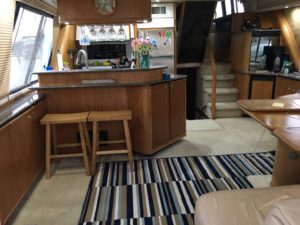
Multiple decks, lots of room! No slides, but still a wide beam. Our RVs have always been slide-free, and well designed to take advantage of the space available. Boats don’t typically come with slides, but they do tend to be much wider than RVs – even those with slides. At least, in the motoryacht designs. Ours is 15′ wide as opposed to our 8′ wide bus conversion. We’re loving the wider living spaces.
- Multi-dimensional living areas. We technically have four levels in our new home and several distinct living areas. Our RV is basically a hallway – one level broken up into a bedroom, bathroom and living/kitchen/office area. We’re loving the space to spread out and be in different rooms.
- Outdoor Space. While some RVs are coming with fold out patios these days, boats tend to have outdoor spaces as as standard feature. We have a shaded back porch, a covered upper deck and an open bow deck. They have become our ‘yard’, and it comes with us wherever we go.
-
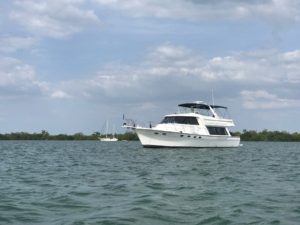
Your view is constantly changing when ‘boondocked’ in a boat. Always in Motion. Once parked, an RV might rock a bit as folks move about or the wind blows really hard. Usually, your view doesn’t change too much once you’re settled in. But there is no such thing as still on a boat. Every little wave in a marina rocks you about. The wind blows, tidal changes, critters swimming by. When at anchor, you’re constantly swinging around the anchor as the wind changes (the bow of the boat wants to be headed into the wind). I honestly was a bit concerned about this as I can be ‘motion sensitive’. It’s not been a problem at all, and we’re finding it really relaxing and cool. Even when stopped, our view is always changing!
- Names. Oh goodnesss, the names that boaters use to refer to areas of their boat are at first confusing. Here’s some sample boat lingo:
- Head = Bathroom
- Berth = Bed or bunk
- Stateroom / Cabin = Bedroom
- Companionway = Hallway
- Cockpit = Water Level Back Porch (funny, I thought the cockpit was where you piloted from?)
- Pilothouse / Helm = Where you drive from
- Flybridge = The upstairs outdoor place you can also drive from
- Salon = Living Room (or, saloon is how some spell it)
- Galley = Kitchen
Systems
Boats and RVs have similar systems – so our transition was pretty easy there. We’re used to dealing with features of a mobile house – holding tanks, inverters & batteries, water pumps, engines, generators, etc.
But there are some pretty substantial differences too!
-
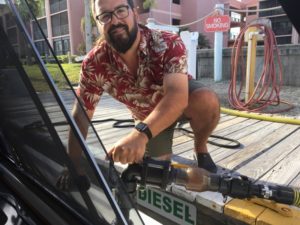
Pumping our Tanks! Holding Tanks – Like RVs, boats have fresh water tanks and black water (toilet). But boats don’t tend to have gray tanks for shower/sink water. That water is pumped overboard, untreated, directly into the water you’re floating in. It makes you VERY aware of what you’re putting down a drain. It’s also kinda fun to stand under the shower a little longer without fear of filling the gray tank.
- Pumping Not Dumping – Most RVs are set up with a gravity dump system to dispose of black and grey water. You hook up a hose to a sewer, open a valve and flush away. On a boat, the black tank has an opening at the top, and you use a pump-out – a long hose the sucks the poopy-water out.
- Water Cooling – On an RV, engines and such are air cooled. On a boat, they’re water cooled – pumping raw water through them for heat exchange. Our engines (2 for propulsion and our generator) and our 3 air conditioners are all run this way.
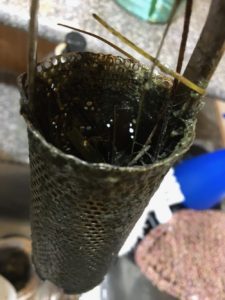
Sea Strainers – keeps the gunk out of our engines and A/Cs. This means on top of changing oil & fuel filters, we also have to regularly clean sea strainers – the filter that keeps the gunk in the water out of the boat systems. They’re mesh baskets that catch all the stuff in the water that is pumped through. This can be seaweed, mud or even jellyfish – we didn’t find those often in our RV filters!
- Pumps galore!! – We have pumps everywhere to help keep water where it’s supposed to be. There’s of course our fresh water pump that delivers to our sinks & showers. There’s sump pumps, that pump grey water up from below the waterline to overboard (3 of those). There’s bilge pumps, that pump any water that gets into the boat back out (we have 6 on board – 3 are automatically triggered by float switches, and then each has a manual back-up pump). And then each engine & A/C has a water intake pump for their cooling systems. That’s a lot of pumps (17?) – and each critical!
-
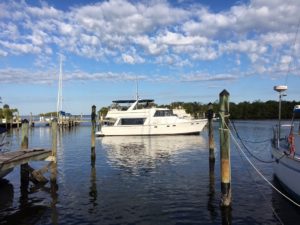
A nice super calm day – no wind to worry about! Look Ma – No Brakes! – RVs have tires and wheels, which boats obviously don’t. But an important element to keep in mind is that boats don’t have brakes either! You are at the mercy of currents, tides, winds and wake from other boats – and you have to be constantly compensating with your engines and steerage. When approaching docks and objects, you never move faster than you want to impact something. When pulling in it’s not so easy to stop, get out, assess the approach plan and trim back a tree limb in the way. Nope, you have to read the wind & currents and try to aim into a tiny slip that might be no more than a foot wider than your boat (usually with an expensive boat next to and across from you) and do your best to get your first line out that acts as your brake. Docking is far more terrifying than backing an RV into a tight campsite.
Places to Park / Dock
In RVing we have three basic options for places to park our bus: Boondocking, dry camping in developed campgrounds and campgrounds with amenities. And boats have very similar equivalents:
-
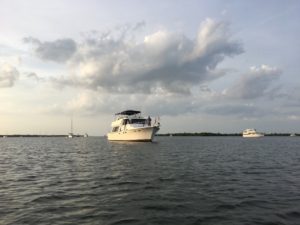
Anchored about… ahhh.. bliss! Anchoring / Boondocking – These are generally free places to stay that are publicly owned. No amenities are usually provided. You just show up, pick a place that’s not encroaching on others and setup. With an RV, you make sure the ground is firm enough and park – it’s generally assumed your RV won’t drift away. With a boat, you drop your anchor and set a GPS-based alarm to make sure your anchor is holding. Anchoring is very common in the boat lifestyle, and from an initial glance seem to be far more abundant than boondocking options. Particularly in the eastern half of the US. We’ve now spent 9 nights ‘on the hook’, and adore it.
- Mooring / Dry Camping – In RVing, there are campgrounds with designated campsites that don’t provide hook-ups. These might be forest service campgrounds or state parks. The equivalent in boating seems to be mooring balls. These are anchors that are more permanently placed with a white floating ball with a blue stripe to mark them – and are usually run by marinas and/or municipalities. You grab the mooring ball and tie up to it. You can then use your dingy to get ashore to a dock for access to the marina & town amenities. Once we have a dingy, we’re looking forward to trying this – it’s a lot more affordable than most marina slips.
- Marinas / Campgrounds – And just like in the RV world, there are places to pull your home into and hook into amenities. Here’s some of the difference we’ve noticed so far:
- Marinas offer slips that you rent by the day ($$$$$$), week ($$$$$) or month ($$) – and are charged by the length of your boat, plus you almost always pay electric on top of it. It’s not often we run into RV parks that charge by the foot. By the day, most marinas are ridiculously expensive – $1.50 – $4.00 per foot plus electric (at 47 feet, were looking at $70 – 180/night). But monthly isn’t so bad, we’ve been paying about $14-15/foot plus a liveaboard surcharge ($700-950/month in total) – which is much cheaper than many RV options around south Florida.
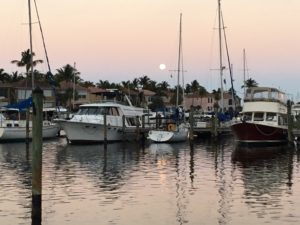
Our first marina – while we were surrounded by boats, hardly anyone was ever aboard them. - You will not likely have more than a few feet between you and your neighbor – marinas can feel much more packed in than even the tightest of RV parks.
- BUT.. unlike RV parks where almost every RV parked has someone staying in it – marinas are also used as wet storage for local boats. Which means, in many marinas you may only be one of a handful of folks actually on your boat. We’ve only been in two marinas so far, but we are digging that aspect.
- BUT AGAIN… marinas are also where a lot of work on boats is done. And boats require a lot of work. Which means marinas may not necessarily be quiet.
- Apparently, as we head out of Florida along the loop, there will be more options for free/cheap overnight docks hosted by cities.
- Marinas offer slips that you rent by the day ($$$$$$), week ($$$$$) or month ($$) – and are charged by the length of your boat, plus you almost always pay electric on top of it. It’s not often we run into RV parks that charge by the foot. By the day, most marinas are ridiculously expensive – $1.50 – $4.00 per foot plus electric (at 47 feet, were looking at $70 – 180/night). But monthly isn’t so bad, we’ve been paying about $14-15/foot plus a liveaboard surcharge ($700-950/month in total) – which is much cheaper than many RV options around south Florida.
And just like finding RV parking options (using resources like All Stays, Campendium, FreeCampsites.Net, etc), there are similar resources for finding boat parking (Active Captain, Waterway Guide and Skipper Bob’s).
And apparently, dock-surfing is a thing too. We’re already starting to get invitations to visit folks who live along waterways and have deep water docks and anchorages. We’ve not yet found a Harvest Hosts equivalent – maybe Don & Kim can find us some wineries with water access???
Wrap Up and Related Posts
So there you have it, our initial thoughts on how RVing and cruising are different. I’m sure in a few months, we’ll have much more to add – especially after we have some data accumulated to start comparing the costs.
We’re working on an upcoming post with more on why we ended up with a Bayliner 4788, and then we’ll get to sharing our very first repositioning as we officially started the Great Loop last month!

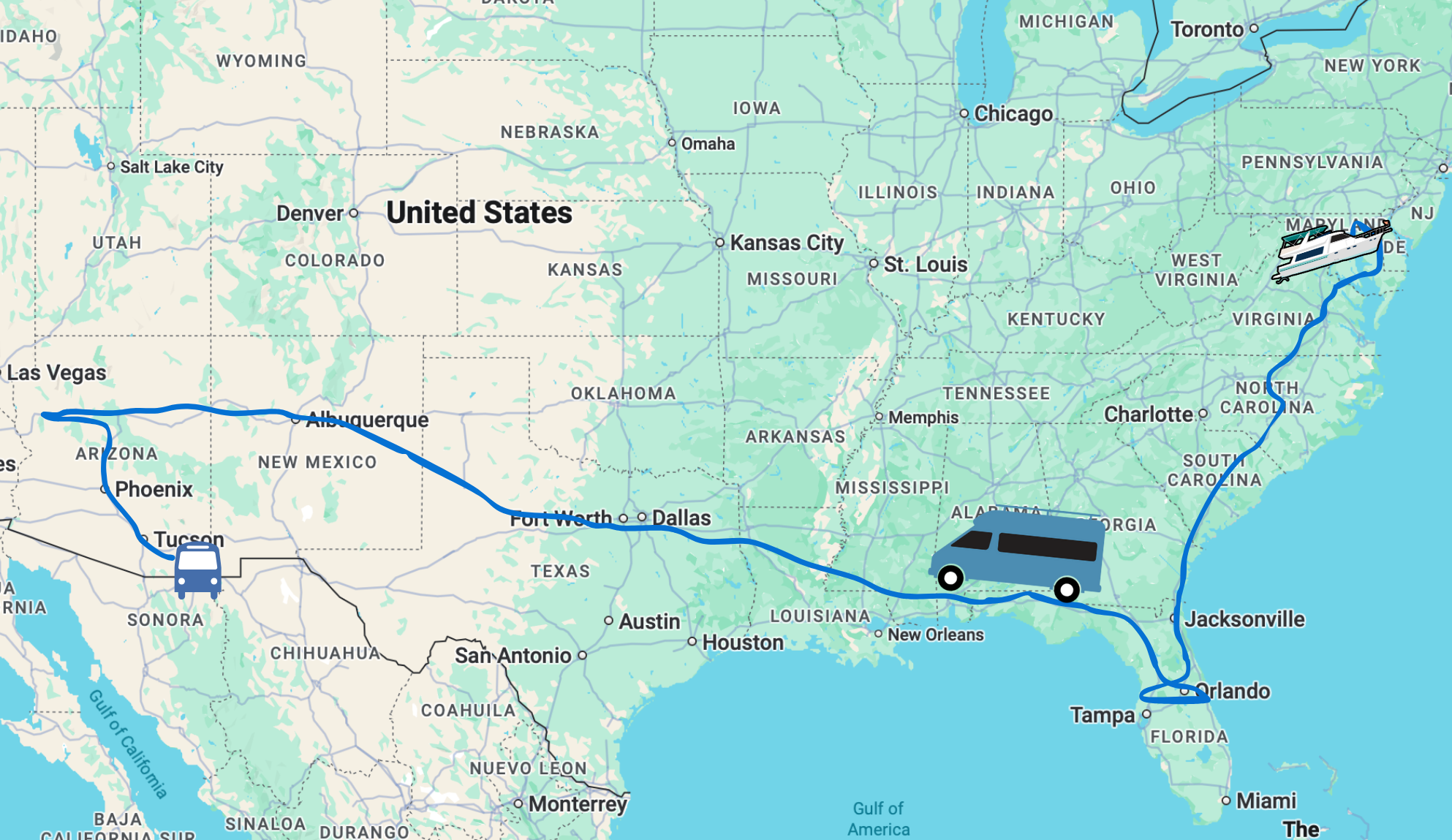
We were part time boaters with a 42′ motor yacht and now we will part time rv with a 31′ fifth wheel. We were able to go from Gaspirilla, FL, where we purchased the boat to Brewerton, NY but because of health issues, we were unable to finish the loop.
I miss the 200 gallon water tank on the boat and the ease of getting rid of gray water. We enjoyed the boat a bit more while we were hopscotching our vehicle around and were able to see surrounding areas, eat at local restaurants and easily get to the grocery store, but that is just us. Many folks survive nicely without a vehicle. Traveling on the waterway gives a new perspective and you see things that you would not see when land traveling. Wait until you pass the Statue of Liberty in your boat. Pretty awe-inspiring.
Of course, we are MUCH older than you guys and have some health issues so we were unable to walk very far or ride a bike so we often rented a car when we didn’t have our private vehicle with us. Marina cars are often ancient and there is usually a mileage limit, so while you can go to the grocery store you obviously can’t go sightseeing because someone else needs to do their grocery shopping and laundry.
We are finding the RV freeing. Once unhitched, we can do all the sightseeing that we want. Need more groceries, easy-peasy to get them. Here in the east, there aren’t many boondocking spots but we have added solar to the rv and are looking forward to going west.
There are so many things to see and do in the US. Whether your mode of travel is a boat or rv, or even traveling in your car – it is great to see and experience this wonderful country of ours.
Love the traveling part of the blog and also the technical “stuff”. Thank you.
I’m another long time RV’er who bought an ocean going cruising sailboat last year, I agree with your comparisons. I was surprised you didn’t mention any comparison for TV, phone & internet services. I guess there’s not a big difference until you get offshore.
I’ve run into several marinas (usually the higher cost “resort” type) who don’t allow any maintenance work at their docks. similar to some RV Park resorts
Boating & RV’ing also both share disputes over “parking” restrictions. Some local gov in Fl especially, have begun restricting where boats can anchor even on public waterways.
Another factor that’s much more critical in boating is the weather; more so offshore but almost every boater looks for detailed weather, winds, sea state & tide details before making travel & anchor plans. A bad weather day in an RV can be an inconvenience, in a boat in the wrong place it can be an emergency.
As other comments point out, ground transportation is something boaters need to plan for occasionally. Although most boaters carry or tow some type of dinghy to get them ashore when anchored out, once on shore walking to the local grocery, hardware or propane store isn’t always possible. I’ve used Uber, public transportation, taxis, and Enterprise rentals for local ground transportation when anchored or docked for re-provisioning the boat.
Indeed.. for the type of cruising we’ll be doing (inland waterways) – it’s pretty darn similar to RVing. One reason we chose this adventure is because providing information on mobile internet for RVing is part of our income source. The Great Loop will keep us in tune with that.
The other issue I forgot to mention above. As a solo, I found out quickly that operating a large boat is much more difficult than an RV when single. Whether motoring or sailing, it seems there are frequently 3 things to do at once and only having 2 hands onboard can be a limitation requiring modified techniques. On the other hand, the boat has an Auto-Pilot that the RV doesn’t. I’m still getting used to trusting the Auto-Pilot. Offshore where you have lots of space its easy to trust the Auto-Pilot. But on the ICW with its heavy traffic, frequent obstructions & almost constant turns, I only felt comfortable taking short breaks with the Auto-Pilot.
Fantastic description and contrast of both worlds. I could’t agree more with you on the docking! Way more terrifying than parking an RV.
Sure, we may get tights spots in the RV, or even sink into the ground on occasion… but it’s nothing compared to dealing with docking. So great to hear from you guys and that you’re just totally rocking the boat life too!!
Technical question
What are the guidelines for Y-valves?
Under federal law, if a boat has a Y valve allowing direct overboard discharge of untreated waste, it must be closed while operating in all inland and coastal waters. It is suggested you use a non-releasable wire tie, lock, or remove the valve handle to secure the device. When you are more than three miles offshore in the ocean, the Y valve may be open allowing direct discharge overboard.
A Y valve may also be found on boats having both a Type I or II MSD and a holding tank. This gives the boater an option to discharge treated waste overboard or to contain it for pumpout later.
I’m assuming you have a Y type valve on your black holding tank
Please bear in mind I’m not insinuating anything this is just a technical question
when you’re training captain was teaching you,, what was his take to you on this process
And have you ever been question at any time on it
Ours is definitely setup to be in compliance.
Fascinating piece. Thanks so much for sharing.
I enjoyed this post. I’m a boater who started RV-ing so it was fun to compare my thoughts as I read yours.
I think the biggest difference for me is that RV-ing seems so “easy” compared to boating. That’s not to say it’s always easy, but I have never once worried about my RV rolling away while I sleep, and although I keep an eye on the weather, my RV life isn’t ruled by it to the same extent. For example, there are only a few days I wouldn’t drive at all; whereas there are many more that I wouldn’t set sail.
On the other hand, RV-ing I miss that only certain land is public, whereas on the water it’s all public (with a few notable exceptions – most of which are probably in Florida).
Dinghying around is something I miss, and I sometimes forget that the space outside the RV is also mine to use – gee, you can just set out chairs and they don’t sink! But then I do miss the cockpit. The RV just doesn’t have that “entry porch all purpose outdoor room” in quite the same way. And I miss my own personal moat everywhere I go!
I still feel weird saying “kitchen, bathroom,” etc. in the RV. Speaking of which, I’ve always thought of a companionway as a doorway/transition, and an interior hallway as a passageway. But there’s often variation in terms. Firmly in the saloon camp though vs. salon.
Currently, I’m still a bit stuck in the “but now I have this HOME to store if I want to go boating” stage. I do love my RV, but it’s not quite as easy to just leave at the launch ramp (or wherever) as something like an old pickup truck. It’s also home, has batteries, personal things, and etc.
I enjoy every one of your posts, but the ones about your new boating life are even more interesting. Bring them on!
PS: I’m more of an anchor-outer, but that’s so true about most boats in marinas being unattended and only used occasionally. Also you made me think about how, yeah, dockside projects (with dust/noise/stuff) are almost a way of life in marinas, but you virtually never see that in an RV park (and it wouldn’t be tolerated even if someone tried). Boatyards take that a few steps further and are little support communities for big projects (while you live on stilts….)
It’s so fun for us to read the thoughts of someone kinda on the other side of the fence… thanks so much for sharing your comparisons of boat life to your newer RV life! There’s a lot about RVing that is easier indeed.
And storing a home is so much different than storing a vehicle. We struggle with that, and will likely continue to.
But all and all, I think we’re going to enjoy mixing it up.
I second the other guy’s question on the Mini. Do you guys see yourselves occasionally renting a car if you are going to anchor for an extended time? Anyway, as an RVer with no interest in boats, and to my complete surprise, I am finding this boat stuff absolutely fascinating especially when written through the lens of RVers such as yourselves. You guys are becoming quite the ambidextrous nomads in keeping your legacy audience interested. 🙂
Glad the content so far is keeping RVers interested too 🙂 We will of course have extending RVing time in our travels.
As far as the Mini:
For parts of this summer, we’ll likely just hopscotch the Mini between marinas – since we’re not making too many miles. We can do day rentals to reposition – or as the case when we pulled into this marina, our neighbor offered to give us a ride to fetch our car. It’s actually pretty common amongst cruisers, and marinas tend to not mind you using their lot as short term storage.
At some point, we’ll transition however – leaving the Mini behind in storage and finding marinas in walking distance to stuff (much more common than RV parks – we have a grocery store a block away here), using Lyft, borrowing marina courtesy cars or renting a car.
What a wonderful, fresh look at the transition from RV to boating. I’ve been around boats most of my life and just RVing for the past year so I’m learning the opposite transition. Two comments:
After a while you’ll find that the ‘always in motion’ is like a white noise. In fact don’t be surprised if you are on the Loop and you wake up at 3:00 am then get out to check why the boat is so still.
Always sailed/cruised on west coast tidal waters and I’ve never had to pump out the black tanks – just use the macerator when cruising. Is pumping the black tank a Looper thing?
Really enjoy your posts.
Thanks.. transitions are fun, aren’t they?
At least on this side of the coast, it’s illegal to dump untreated black waste less then 3 miles off the coast. We’ll hardly ever be in those conditions.
I am very curious to see how you get along without the Mini as you travel from port to port.
For parts of this summer, we’ll likely just hopscotch the Mini between marinas – since we’re not making too many miles. We can do day rentals to reposition – or as the case when we pulled into this marina, our neighbor offered to give us a ride to fetch our car. It’s actually pretty common amongst cruisers, and marinas tend to not mind you using their lot as short term storage.
At some point, we’ll transition however – leaving the Mini behind in storage and finding marinas in walking distance to stuff (much more common than RV parks – we have a grocery store a block away here), using Lyft, borrowing marina courtesy cars or renting a car.